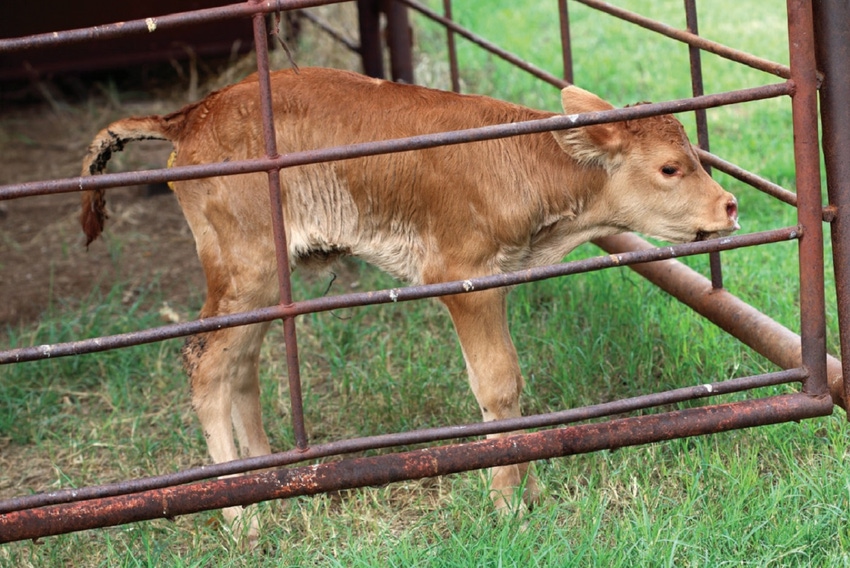
Intervention to cure calf scours is a complex thing, and the disease often has lasting effects. Scours and its recovery are highly affected by age of the calf and species of pathogens, and also by level of dehydration, nutritional status, maternal transfer of antibodies through the colostrum, electrolyte loss, gut pH and condition, hypothermia, and even the development of septicemia.
Sorting through these issues with help from your veterinarian will have great influence on your success or failure, says Mark Alley, a North Carolina-based large-animal veterinarian who now works for Zoetis.
The damage from calf scours is significant. Above and beyond treatment costs and death loss, research studies have showed weight loss in previously scoured calves at weaning can run from 20 to 35 pounds, Alley says.
And if calf scours and lost gain aren’t bad enough, plenty of data show scours is one harbinger of health problems yet to come. Respiratory disease often follows two to three months later.
In a 2013 study of producers across six states, detection of bovine respiratory disease in nursing calves was significantly associated with large herd size, detection of BRD in cows, and diarrhea in calves. Also, calving season length was associated with BRD in calves in Plains states but not in Eastern states. In a survey of veterinarians across six states in 2013, they reported 18% of their cow-calf clients nursing calf respiratory disease in the previous year, and 14% had at least one nursing calf die of BRD. Those veterinarians listed calf diarrhea in the herd as one of several likely causative factors.
Other probable causative factors the surveyed veterinarians listed were:
weather
inadequate colostrum
introducing new cattle
failure to give nursing calves BRD vaccines
failure to give cows BRD vaccines
vitamin or mineral deficiency in cows or calves
protein or energy deficiency in cows or calves
bovine viral diarrhea virus-persistent infection cattle in herd
calving in confinement
In an unpublished study by veterinarian David R. Smith, beef cattle epidemiologist at Mississippi State University veterinary college, the yearly variation in BRD incidence in nursing calves was significant. This was from a study of nearly 15,000 steer calves across 14 years. The highest incidence of BRD typically occurred around 120 days. Also, Smith’s data showed no apparent relationship between ranch BRD and feedlot BRD.
Another study from the U.S. Meat Animal Research Center with about 115,000 calves over 20 years showed two periods of high BRD incidence: one in the first 20 days of life, and the other from about 75 or 80 days to 150 or 160 days.
Smith suggested this data shows BRD is more sporadic in younger calves and tends to occur as outbreaks in older nursing calves. In younger calves, he said it more likely results from failure of passive immunity from the dam. In older nursing calves, it is more likely the result of waning passive immunity and a lack of herd immunity.
The data also showed 2- and 3-year-old cows are more likely to have calves with BRD. Smith also noted bulls were most likely to suffer nursing calf BRD, followed by steers and then heifers.
Can antibiotics help?
When a scours outbreak begins, producers sometimes want a veterinarian to help diagnose scours pathogens by color of the scours, but Alley says a much better indicator is the age of the calf.
Age of calf can help because the various pathogens tend to have different timing of outbreak by age. Stool samples may help, but they deteriorate very rapidly.
The number of antibiotics approved for scours are limited as well, Alley warns. Veterinarians are most likely to prescribe antibiotics if the calf has a temperature above 104 degrees, has blood in its stools, or didn’t receive adequate colostrum.
If you find yourself in an outbreak without prior vaccination, you might try vaccinating calves at birth, Alley suggests. Much better would be combining scours prevention vaccines with a management practice such as the Sandhills Calving System, where older calves and their dams are left behind and uncalved cows are moved to fresh pasture every couple of weeks. This helps reduce the pathogen load for new calves. Another long-term remedy is to avoid winter calving.
Once the storm is over, work with your veterinarian on future prevention, Alley recommends. Your plan should include nutrition, biosecurity, biocontainment and possibly vaccines.
About the Author(s)
You May Also Like




